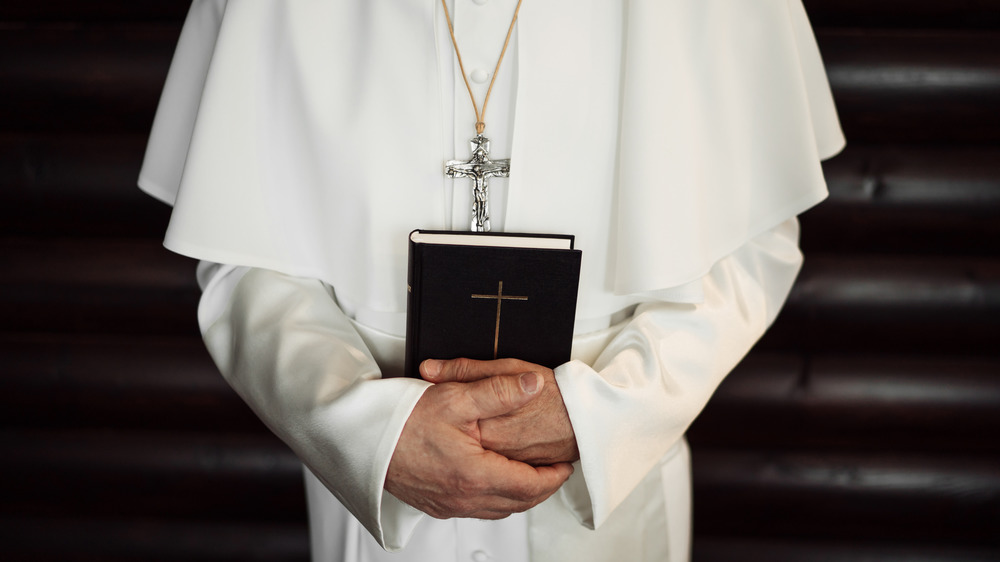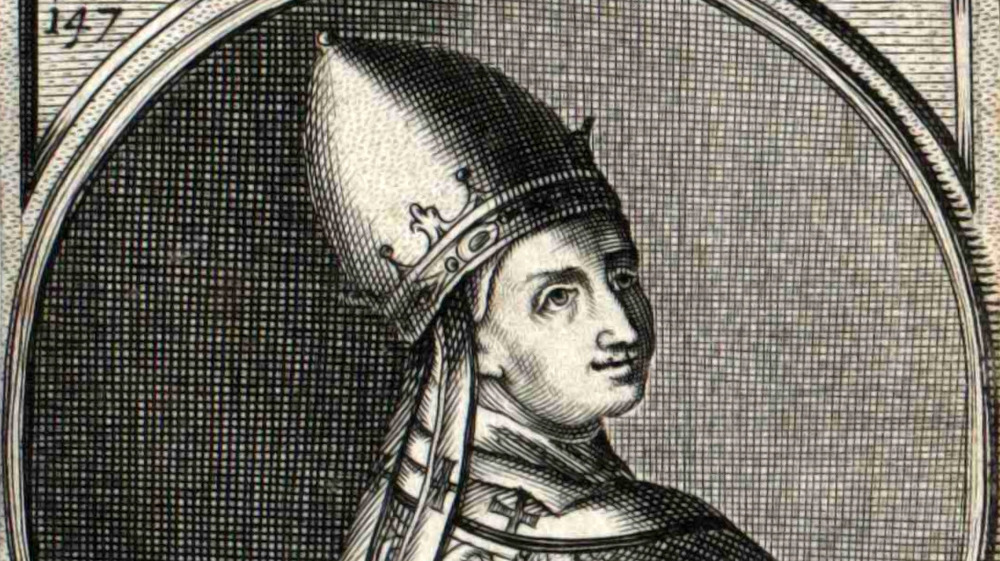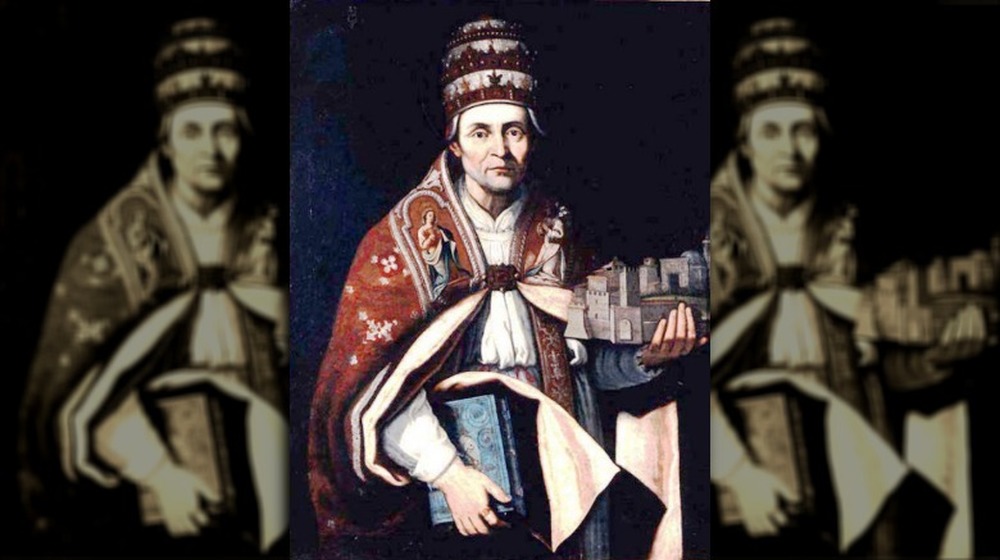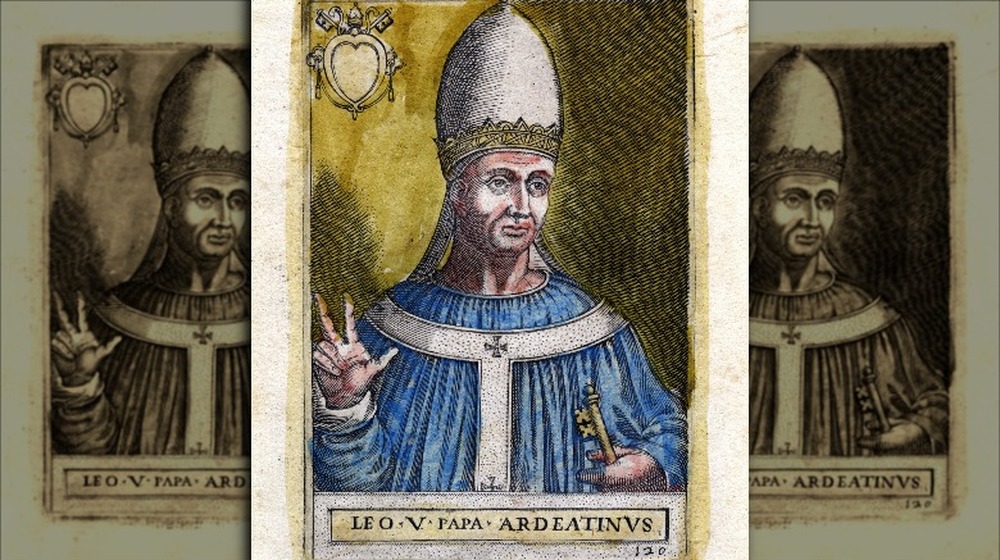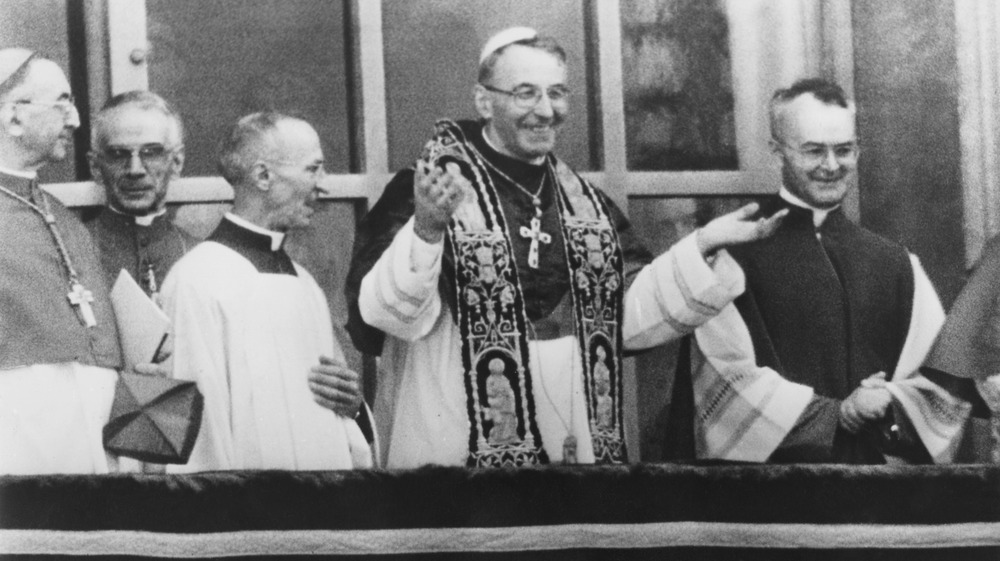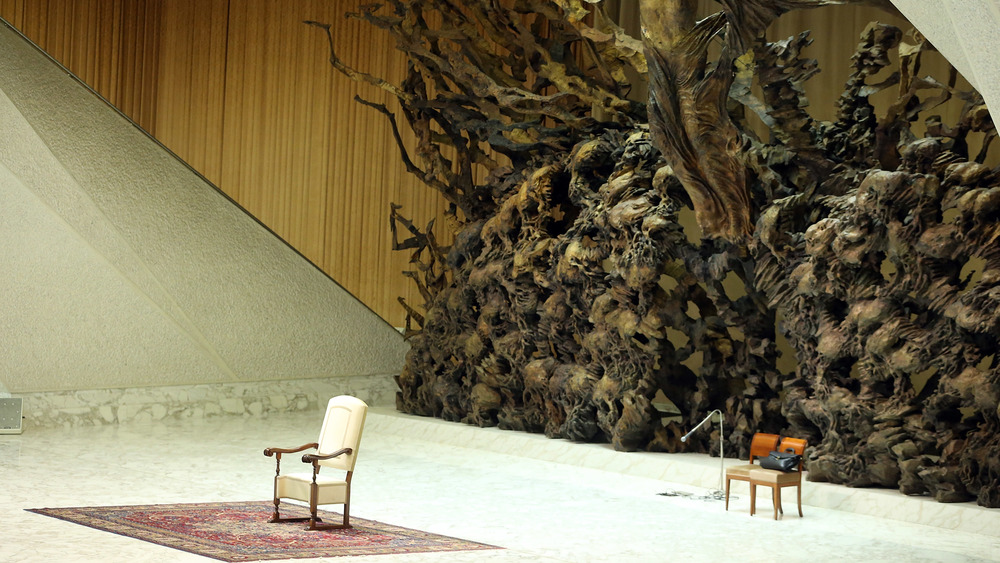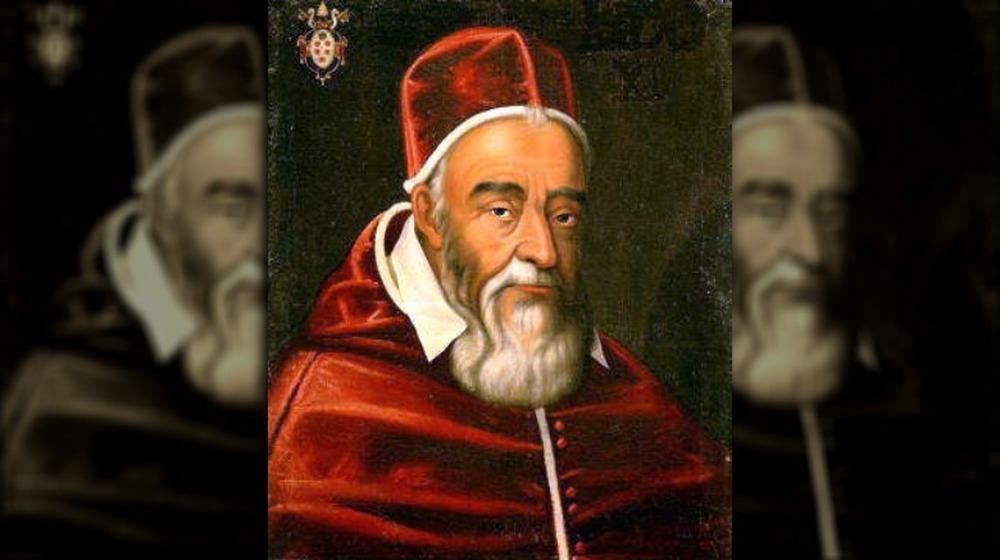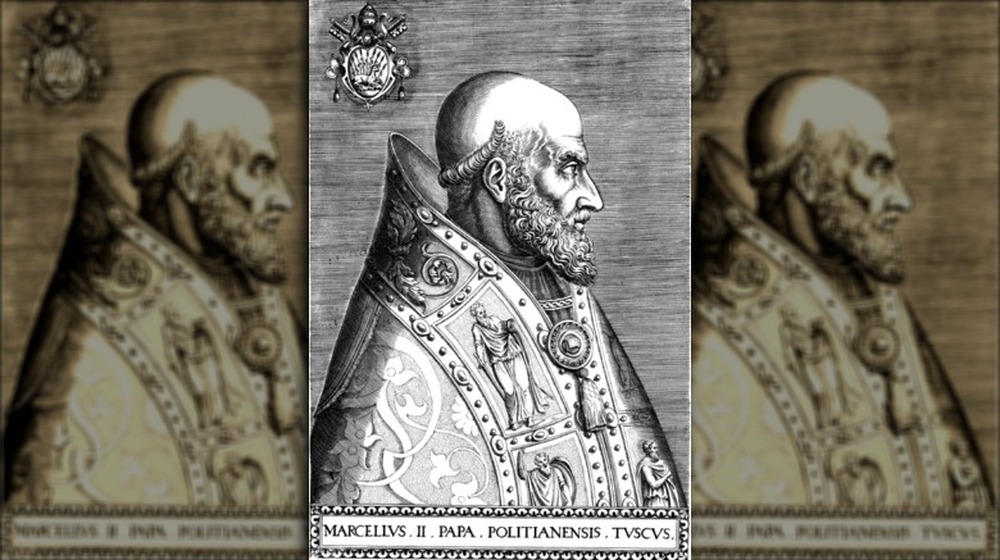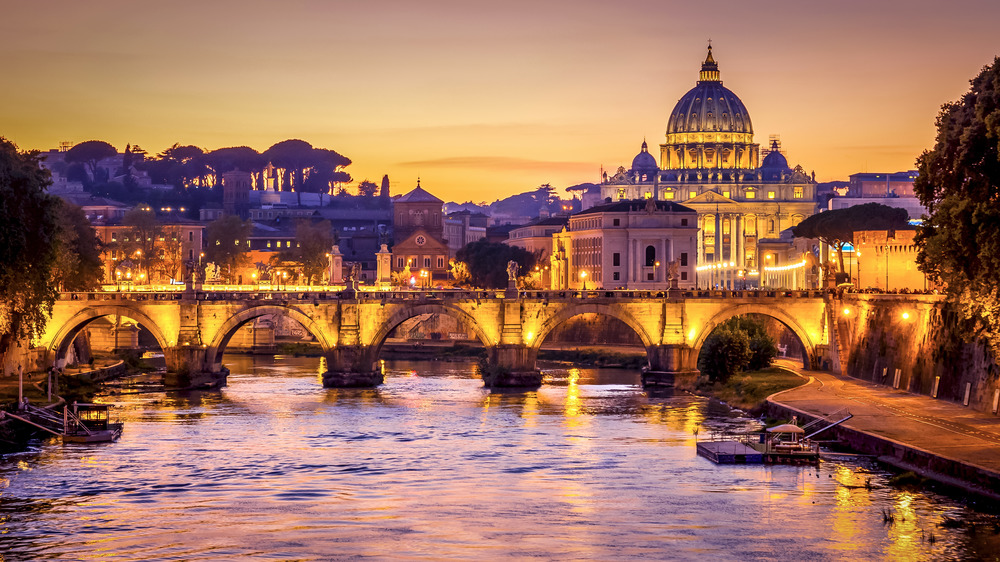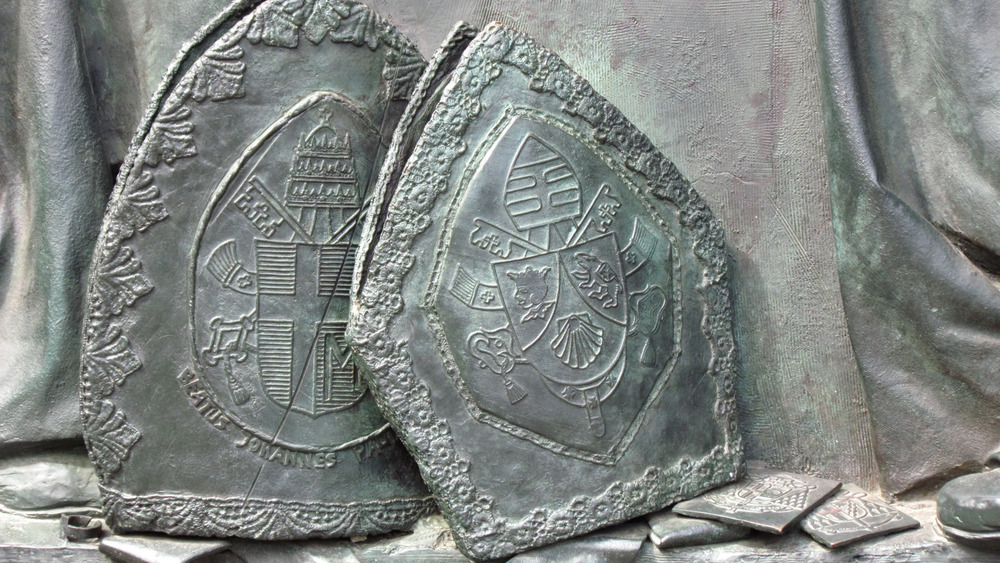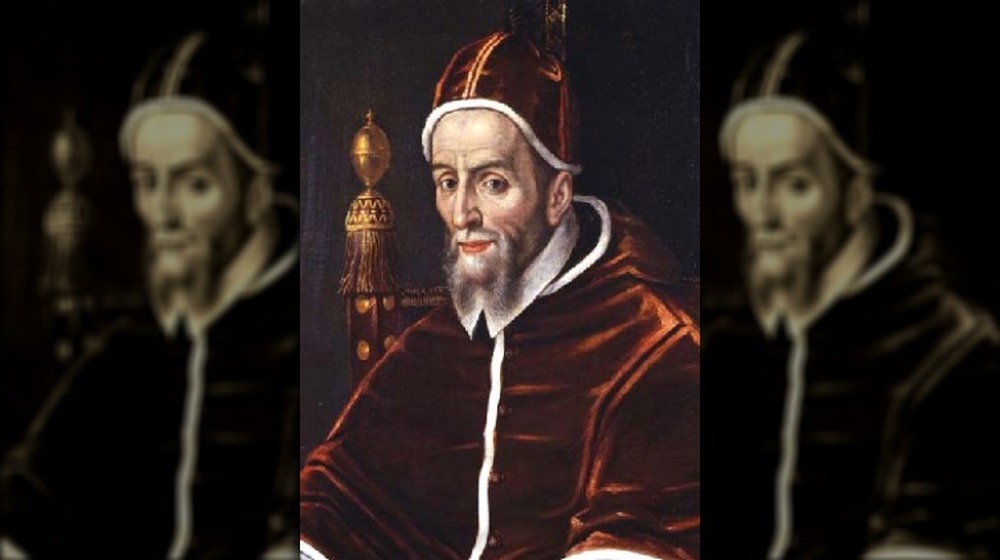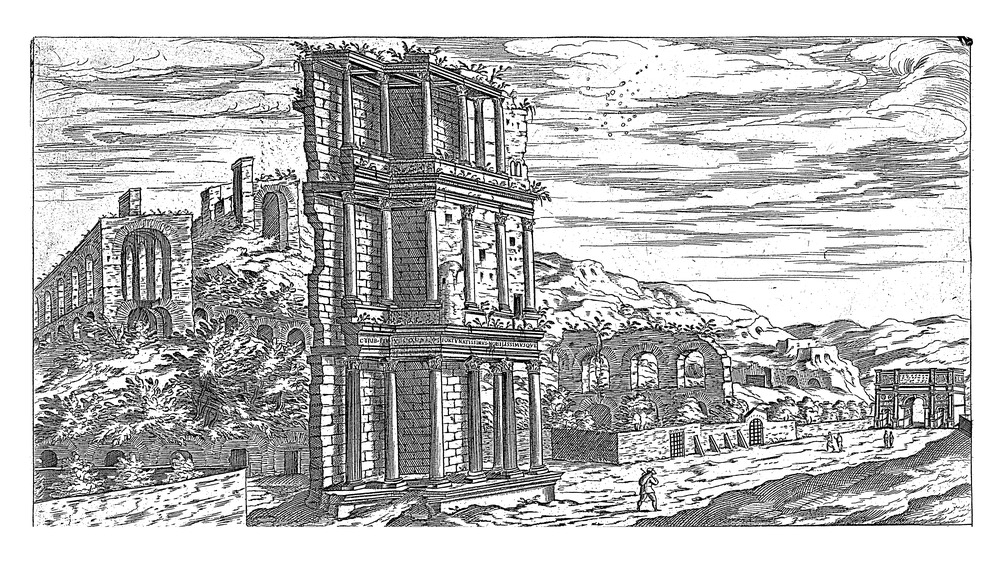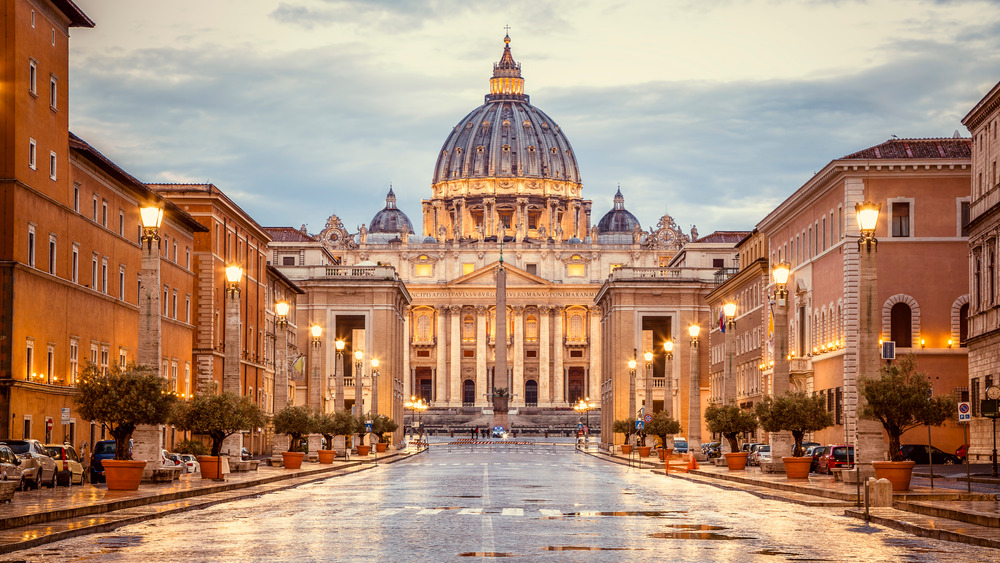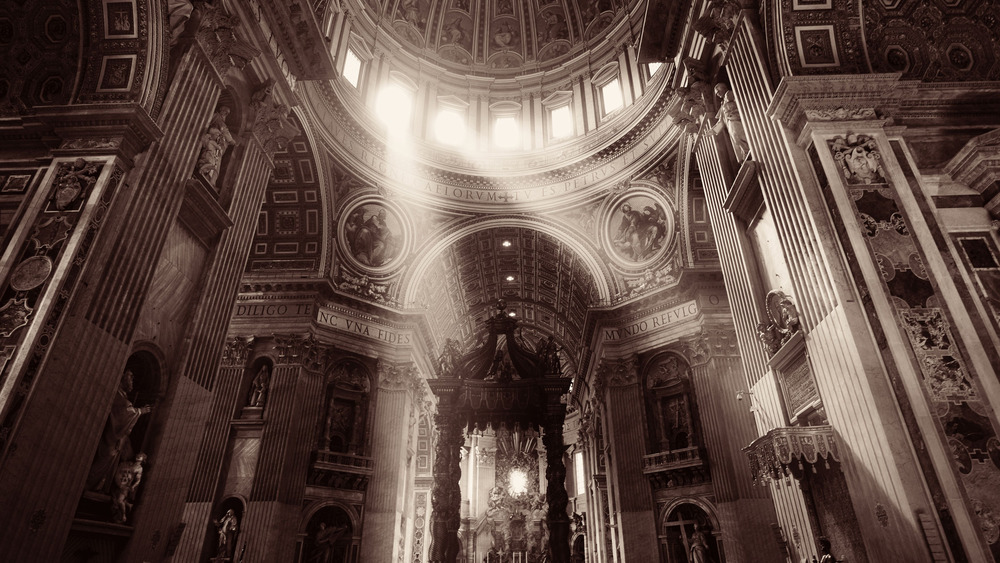The Strangest Stories Behind The Shortest Reigns In Papal History
The Vatican City as we know it — as a sovereign nation — was established much more recently than most might think: in 1929. The Vatican as an entity and the papacy as an organization go back much farther, though, and according to History, the founding of the Vatican really began in the 4th century.
That's when St. Peter's Basilica was built over the tomb of the man who is widely considered to be the first pope, but things get really weird almost immediately. According to Irish Catholic, it's widely accepted that St. Peter was the first pope, but no one's entirely sure who the second one was. St. Linus is a popular contender, but history remembers almost nothing about him. It doesn't get any less complicated as things like record-keeping got better, either. The history of the papacy is filled with (sometimes bloody) conflict, drama, intrigue, and quite a bit of confusion. There aren't just popes but there's antipopes, too, and heck, no one's even sure how the Pope Stephens should be numbered thanks to the insane amount of drama that went on there. Bottom line? The history of the papacy is a mess.
While some sat at the head of the church for years and made sweeping changes (for better or worse), others had incredibly brief reigns punctuated by all kinds of drama. Let's talk about those guys.
Benedict IX: 12 years... then two months... then eight months
The longest-reigning Pope was Pius IX, and The Guardian says he reigned for a whopping 31 years, 7 months, and 23 days. That makes Benedict IX's 12 years sound not-too-shabby, but it's his second and third term as pope that get interesting.
He first became pope in 1032 (via Britannica), and while his exact birthdate isn't known, Business Insider says that (it's most likely) he first rose to power when he was just 12-years-old. He was the target of an assassination attempt in 1032 but hung in there until 1045, when the people of Rome decided they'd had enough and quite literally ran him out of the city. He was replaced by Sylvester III, but just two months later, Benedict IX was back. Only two months went by, and a few things happened: he inherited a ton of money, got fed up with his papal duties, and he also decided he wanted to marry his cousin. (They were different times.) So, he abdicated after just eight weeks.
There were a few more popes, and in 1047, Benedict IX returned. Contemporaries say his cousin hadn't accepted his marriage proposal, so he decided to stick with the whole religious thing. He took the papacy back after the death of Clement II, and after just eight months, the Holy Roman Emperor Henry III had enough of him, and ran him out of town. Again.
Celestine V: 5 months
Most men who become pope want to be there, but Pietro del Morrone wanted none of that. According to Bristol University's George Ferzoco (via NPR), he spent most of his life as a monk and a hermit. He lived in a cave in the mountains, wore hair shirts and iron chains as part of his penance, and was perfectly happy with his choices in life.
But things changed with the death of Pope Nicholas IV in 1292. No one could decide who was going to be the next pope, so everyone basically got together and decided they were going to appoint someone old and easy to manipulate. They had heard of this saintly hermit, so they headed off to his mountaintop, told him he was going to be pope, then loaded him up and took him back to Rome. It went about as well as could be expected, and while he made a lot of not-so-great decisions — in part because he spoke next to no Latin whatsoever — he also signed a document making it legal for a pope to resign. And then, he resigned.
While Celestine V wanted nothing more than to go back to his cave, his rocks, and his hair shirt, his successor wasn't comfortable with having such a popular ex-pope around. Celestine V was arrested and imprisoned, where he died shortly after. He's since been both canonized, and unfairly sent to hell in Dante's Divine Comedy.
Leo V: 2 months
Leo V was pope in 903, but it just goes to show that sometimes, you might be better off not getting what you want. He stepped into the papacy in August, and by September, he was dead (via Britannica).
Catholic 365 says that at the time Leo V stepped in, the whole thing was a bit of a shambles. Various families were fighting for control, and while it's not clear, it seems that history remembers Leo V as sort of a compromise. In other words, no one actually got what they wanted, least of all, Leo himself.
He hadn't been pope long when he was abducted and imprisoned by the man who had been serving as his chaplain. That man — Christopher — then installed himself as the new pope, and the details about his reign get a little murky. There's a few different versions of what happened next (according to Pope History), but the end result is that Leo V died (or was executed, or according to another tale, lived the rest of his life in exile), and Christopher was rather quickly replaced by Pope Sergius III. It's also unclear as to what happened to Christopher, too — in part because Christopher was never really considered a pope, as Leo V had never technically stepped down and the "finders, keepers" rule doesn't apply to the papacy.
John Paul I: 33/34 days
To say that the Catholic Church has a bit of a dodgy history is the understatement of the year, but back in 1978, things were looking up. That, says Inside Hook, is when the Vatican welcomed Pope John Paul I, and people got behind him. He was widely respected — and liked — for his cheery optimism, and his demeanor earned him the nickname of the "Smiling Pope."
He wasn't without detractors, though, and most of those took issue with things like his progressive ideas. (He regularly said that the clergy should actually listen to young people, and that's pretty much revolutionary.) So, it's not entirely surprising that when he died on the night of the 33rd day as Pope, there were rumors he'd been murdered.
At the time, there were plenty of conflicting accounts as to what happened with this relatively young, popular pope. (He was just 65 when he died.) Now, though, The Guardian says that the accepted story is that he headed off to bed around 10 pm, and when he didn't show up for Mass the following morning, his secretary entered his chambers and found him. He had died while reading, and the official cause was a heart attack. (Some have suggested that it was triggered by the intense stress of discovering the full extent of corruption within the Vatican.)
Benedict V: 1 month & 1 day
Britannica says it's not entirely clear whether Benedict V was an official pope or one of the many antipopes, because it was a confusing time. His appointment came in 964, after the death of previous Pope John XII. But here's the thing: as far as Rome was concerned, John XII died and Benedict V was elected. But Beloit College says that Otto I, the Holy Roman Emperor, had a different idea. He was off elsewhere doing his own thing, and he'd actually put together a council of men who had deposed John XII. After deposing him, Otto had thrown his support behind Leo VIII, and was heading to Rome to put his new pope in place when John XII died and was replaced.
Otto wasn't the type to just shrug and go home (or try some back room maneuverings to get Benedict V out of the picture): instead, he laid siege to Rome and did so much damage that historians write that 30 gold coins would buy just the tiniest bit of grain. Rome backed down pretty quickly and handed their new pope over to Otto, who took Benedict V back to Hamburg and allowed him to live out the rest of his days. He'd been pope from May 22 to June 23.
Leo XI: 27 days
Leo XI didn't always follow the righteous, religious path in life... his mother wouldn't let him. He was born Alessandro de' Medici, and as the only son of aristocrats belonging to the infamous de' Medici family, he was originally pushed into the life of a diplomat. Specifically, he was an ambassador to Rome, which gave him the contacts that he needed to become a priest immediately following his mother's death in 1567.
According to Papal Artifacts, Leo XI didn't just see the papacy as another steppingstone and was a devoutly religious man. He spent most of his life walking the line between diplomat and clergyman, and it wasn't until 1605 that he was elected to the papacy. Even though he was already in fragile health, he made some sweeping changes that included reforming the voting methods in the Vatican conclave, and establishing a peace treaty between France and Spain.
He died just 27 days after becoming pope but left a lasting legacy: there's still a monument to him at St. Peter's Basilica, where he sits alongside the figures of Generosity and Fortitude.
Pope Marcellus II: 22 days
Marcello Cervini de Spannocchi — the man who would become Pope Marcellus II — had experience with the Vatican long before he was pope: and it started when church fathers — including Pope Clement VII — commissioned him and his father to help reform the calendar. A scholar and farmer first, it's not entirely surprising that when he finally moved to Rome after the deaths of his parents, SGIRA says he was installed at the head of the Vatican Library (in addition to being appointed to various diplomatic positions). While he was there, he expanded the library exponentially, and acted as a patron to up-and-coming writers.
He was installed as pope on April 10, 1555, and immediately started to do things like cut spending and nepotism alike. According to Papal Artifacts, his papacy was heralded as one that would bring in a complete overhaul of the system... and it probably would have, if he hadn't died just over three weeks into his reign.
After a long and grueling first week of ceremonies, Masses, and meetings, the new pope fell ill and died on May 1, 1555. He was buried first in a simple coffin, was discovered uncorrupted when he was moved in 1606, and was reburied in a previously used sarcophagus (that still bears the images of the original inhabitants) now in St. Peter's Basilica.
Pope Theodore II: 20 (?) days
The papacy — and the church itself — was a total mess in the 9th and 10th centuries. National Geographic says that there were 24 popes between 872 and 965 alone, and while there's not enough time to talk about them all, let's talk about Theodore II. He was pope for just about 20 days at the end of 897, although the exact number varies, as does the month: He's either said to have been pope in November (via the University of Georgia Law School) or December (via Britannica). Either way, it's events that pre-dated him that are super important to his story, and that's the strange tale of the Cadaver Synod.
In a nutshell, that's when Pope Stephen VII had the corpse of his predecessor, Formosus, brought to court to stand trial because... reasons. Stephen found Formosus guilty of pretty much everything, cut off the corpse's fingers, had it reburied, then exhumed again, and pitched into the Tiber River.
Stephen VII was eventually found to be a bit... ill-suited to be pope, so we'll fast-forward to Theodore II. Three months after Stephen's de-popement (de-poping?), Theodore II was appointed and immediately held another synod that restored Formosus to the papacy. A monk had already found the erstwhile former pope's corpse, and Theodore II had it re-clothed in papal vestments and reburied. Just what happened to Theodore II isn't clear, but some historians suggest that his actions in invalidating the Cadaver Synod led to his murder.
Pope Boniface VI: 15 days
There were a lot of popes in the 9th and 10th centuries, and it really says a lot about human nature that they could find anyone who wanted to be pope at all. Basically (and this is a huge oversimplification that'll work for our purposes), there were a lot of factions and families who wanted their guy to be pope, and no one wanted to share power. When Formosus was elected to the papacy he was a highly controversial choice. (As National Geographic notes, he'd already been excommunicated by previous popes, and then reinstated into the church.)
Formosus was pope from 891 to 896, and after his death, the fancy hat passed to Pope Boniface VI. He'd barely gotten time to settle in before he was dead, too — and no one's entirely sure what happened. According to Britannica, some believe he died of natural causes (and a nasty case of gout), while others are pretty sure he was murdered by the man who would become Stephen VII (or Stephen VI, if you're going by the other method of numbering Stephens, because yes, it really is that complicated). He's the guy that would use his papacy to put Formosus' corpse on trial, so the suggestion that he'd murder his predecessor to do so isn't entirely out of left field.
Pope Urban VII: 13 days
Not all popes are officially recognized by the church, which means that when it comes to the very shortest reign of an official pope, that's a dubious honor that goes to Urban VII. Pictures from Italy says that he was elected on September 15, 1590, and his short reign of just 12 days didn't come from any religious coup, power struggle, or family drama, it came from illness.
Specifically, malaria.
That could be it when it comes to Urban VII, but there's a fascinating little footnote to his time as pope. In the 13 days he was in the big chair, he issued what History calls the first smoking ban ever signed into law. It was pretty extreme, too: anyone caught "chewing it, smoking it with a pipe, or sniffing it in powdered form through the nose" while in or immediately outside of a church was punished with excommunication. That law stayed in place until 1724, when Pope Benedict XIII decided he wanted to smoke, so he did away with it.
Celestine IV: 2 days
The papacy is as much about international diplomacy and power as it is religion, and that was definitely the case in the 1220. That, says Oxford Reference, is when Pope Gregory IX died, while two of the cardinals responsible for choosing a new pope were being held as prisoners under the regime of Emperor Frederick II.
That left 10 to choose the new pope, and predictably, they couldn't come to any kind of an agreement. The whole thing dragged on until some of the secular powers-that-be in Rome told them to get moving and just pick someone already — and they encouraged them to hurry the heck up by shipping the 10 off to the crumbling ruins of the ancient Septizodium (pictured) and telling them they couldn't leave until they'd picked a new pope.
Still, the disagreements stood for another two months, and finally — after one of the cardinals died — they decided to elect one of their own: Goffredo da Castiglione, who took the name Celestine IV. Already in ill health from the forced confinement and his advanced age, he died just two days after becoming the first pope officially elected via conclave.
Philip: one day
Philip was elected to the papacy in July of 768, but he's one of a number of men who are more accurately considered an antipope. (Medievalists defines an antipope as someone who is considered a false pope, a rival, or a contested pope — they're not recognized by the church as real popes.)
Philip ended up as pope — briefly — after the duke of Nepi decided to put his brother, Constantine II, on the throne at the death of Pope St. Paul I. Britannica says that's when troops descended on Rome to kill the duke and depose Constantine I, and they then elevated Philip.
That absolutely didn't last, though, and just a day later he was sent packing back to his monastery with the election of Stephen III. (Or Stephen IV, again, depending on which numbering system is being used for the Pope Stephens.) Psychology Today says Philip spent the rest of his life in his monastery, living as a penitent and seeking forgiveness for his sins.
Celestine II: A very short time, indeed
Celestine is apparently the name to take if someone elected to the papacy doesn't really want to be there, because it's not a name that's associated with a long and happy life.
After the death of Callistus II, the families who were involved in a sort of pushing-and-shoving match over the papal throne decided to elect the already elderly Teobaldo Boccapecci, who had been made a cardinal by the previous pope in 1123. Fast forward to December of 1124, and the papal elect — now Celestine II — was donning his papal vestments in the church. According to the Oxford Reference, he was literally still in the church — they had just started the singing portion of the ceremony — when troops belonging to a rival family broke in and started busting heads.
Again, that's very literal. Celestine II sustained such severe wounds that he immediately decided he didn't want to be pope after all, resigned, and was replaced just after putting on the red mantle of the papacy.
